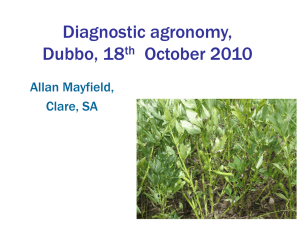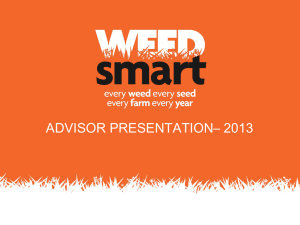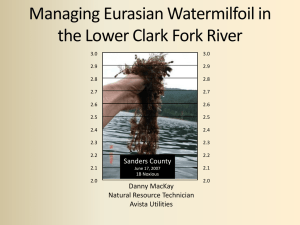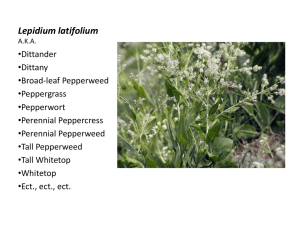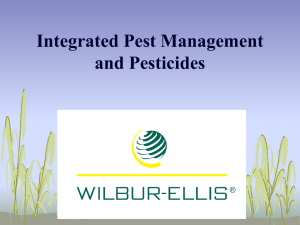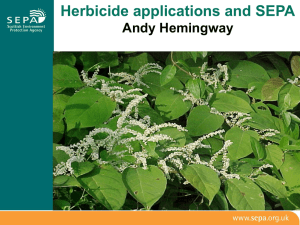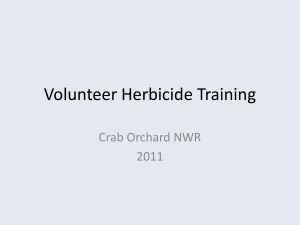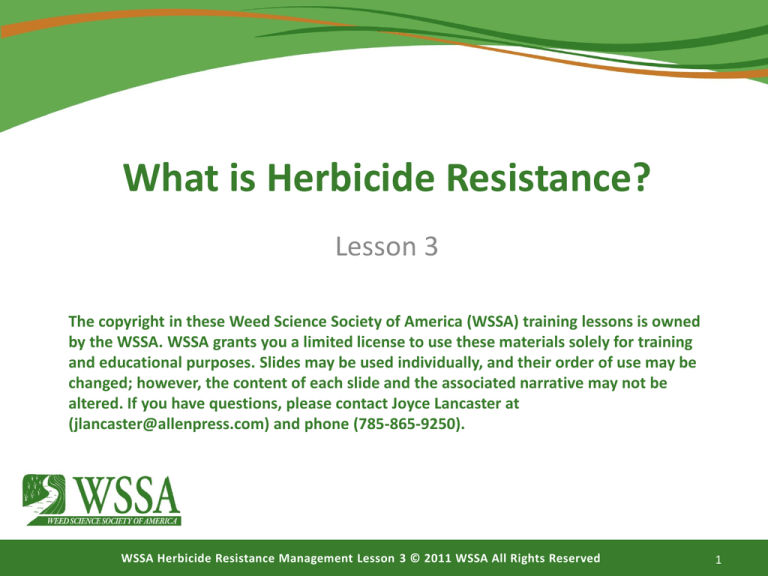
What is Herbicide Resistance?
Lesson 3
The copyright in these Weed Science Society of America (WSSA) training lessons is owned
by the WSSA. WSSA grants you a limited license to use these materials solely for training
and educational purposes. Slides may be used individually, and their order of use may be
changed; however, the content of each slide and the associated narrative may not be
altered. If you have questions, please contact Joyce Lancaster at
(jlancaster@allenpress.com) and phone (785-865-9250).
WSSA Herbicide Resistance Management Lesson 3 © 2011 WSSA All Rights Reserved
1
Objectives
By the end of this lesson, you will:
Understand what herbicide resistance is
and how it evolves in the field.
Recognize the factors that influence
selection for herbicide resistance.
Above: Poa annua plants susceptible
(brown) and resistant (green) to ALSinhibiting herbicides.
Photo credit: Richie Edwards, Panama City, FL.
Define the different types of herbicide
resistance.
WSSA Herbicide Resistance Management Lesson 3 © 2011 WSSA All Rights Reserved
2
Herbicide Resistance Defined
Herbicide resistance can be defined as the acquired ability of a weed population to
survive a herbicide application that previously was known to control the population.
The number of herbicide-resistant individuals in the population changes over time.
Year 1
Year 2
Later years
Herbicide tolerance is the inherent ability of a species to survive and reproduce after
herbicide treatment. There has been no selection acting on the tolerant weed species, and
there has been no change in the weed species lack of response to the herbicide over time.
The number of herbicide-tolerant individuals is not affected directly by the herbicide.
Year 1
Year 2
Later years
WSSA Herbicide Resistance Management Lesson 3 © 2011 WSSA All Rights Reserved
3
Herbicide Resistance: Basic Principles
In general, weed populations are
Herbicide resistance is the result of naturally
occurring
genetically
diverse, andprocesses.
individual
Herbicide-resistant individuals or
biotypes* are present naturally
within the weed population at very
low frequencies. These individuals
have a herbicide resistance
mechanism that allows them to
survive the application of a
herbicide.
Weed control failures do not
automatically mean that the
weeds are herbicide-resistant.
plants within a species can respond
* Biotypes differently
are plantsto the same herbicide rate.
This does
not mean, in all cases, that
within a species
that
the least sensitive individuals are
have biological
herbicide-resistant, but it is a
characteristics
that
possibility. Herbicide rates are initially
are not common
to
established to be effective on the vast
the population
as aof the individuals in a
majority
whole.
population under normal growing
conditions. This is why using labeled
rates is important.
[ClickIt to
close.]
Resistance is heritable.
can
be passed from one
generation to the next.
WSSA Herbicide Resistance Management Lesson 3 © 2011 WSSA All Rights Reserved
4
Selection by Herbicides Changes the
Population Over Time
1
Year 2
Example
Year 2 begins
with more
1 in a million
resistant weeds
Resistant
Susceptible
Spray
weeds
with
weeds
herbicide
produce
weeds
mature
die
seed
resistant to aResistant
herbicide
WSSA Herbicide Resistance Management Lesson 3 © 2011 WSSA All Rights Reserved
5
Selection by Herbicides Changes the
Population Over Time
Year 3
2
Example
And in later years
…Until Year 3 has
even
more herbicideThe process
significant
weed
resistant
weeds
are
repeats…
resistance…
present
WSSA Herbicide Resistance Management Lesson 3 © 2011 WSSA All Rights Reserved
6
Another factor affecting the speed
of selection is the mechanism of
herbicide resistance. There are two
general types of mechanisms: (1)
exclusionary resistance (for
example, differential uptake and
translocation, compartmentalization
and metabolic detoxification) and
(2) target site resistance (alteration
of the targeted enzyme and
overproduction of a specific
enzyme). Exclusionary resistance
generally takes longer to evolve in
the field.
Factors Affecting Speed of Selection
The length of time for selection of resistance varies by :
Cultural practices
Frequency of herbicide use
Herbicide mechanism of action
Biology of weed species
[Click
to close.]
Frequency of resistant biotypes among weed
species
Year 0
Year 2
Year 4
Year 6
Year 8
Year 10
WSSA Herbicide Resistance Management Lesson 3 © 2011 WSSA All Rights Reserved
Later
7
Level of Herbicide Resistance
The level of herbicide resistance in weeds varies
by weed biology and resistance mechanism.
In some cases, resistance occurs when the
species survives application of a labeled rate,
while in other cases, the species can survive up
to 1000 times the labeled rate. (1X equals the labeled
rate.)
This is important in terms of being able
to identify herbicide resistance in the
field.
WSSA Herbicide Resistance Management Lesson 3 © 2011 WSSA All Rights Reserved
8
Herbicide Resistance Characteristics
Low-Level Resistance
High-Level Resistance
– A continuum of plant responses from
slightly injured to nearly dead
– The majority of plants display an
intermediate response
– Susceptible plants will be present in the
population, especially when herbicide
resistance is determined early
– Plants are slightly injured to
uninjured
– Few plants have an intermediate
response
– Susceptible plants can be present in
the population
Examples
atrazine, Princep, Sencor, etc.
Examples
Roundup, etc.
GROUP
9
HERBICIDE
GROUP
5
HERBICIDE
Revolver, Monument, Velocity, etc.
Ronstar, Dismiss, etc.
GROUP
14
HERBICIDE
Banvel, 2,4 D, etc.
GROUP
4
HERBICIDE
Gramoxone, etc.
GROUP
22
HERBICIDE
GROUP
2
HERBICIDE
Acclaim, Fusilade, Segment, etc.
GROUP
WSSA Herbicide Resistance Management Lesson 3 © 2011 WSSA All Rights Reserved
1
HERBICIDE
9
Herbicide Resistance Types
Single Herbicide Resistance
• Resistant to only one herbicide
Cross Herbicide Resistance
• Resistant to two or more herbicide
families with same mechanism of action
• Single resistance mechanism
Multiple Herbicide Resistance
• Resistant to two or more herbicides with
different mechanisms of action
• May be the result of two or more
different resistance mechanisms
WSSA Herbicide Resistance Management Lesson 3 © 2011 WSSA All Rights Reserved
10
Herbicide Resistance Types: Cross Resistance
Example:
Year 1
Apply Revolver®
Resistant to Revolver
Year 2
Apply Revolver
Resistant to Revolver
Year 3
Apply Velocity®
Resistant to Revolver and Velocity
herbicides (group 2, ALS-inhibitors)
Revolver, a sulfonylurea, and Velocity, a pyrimidinyloxybenzoic acid, both belong to the
ALS-inhibitors, or group 2 herbicides. Both herbicide products have the same
mechanism of action.
CAUTION: Weeds that are herbicide-resistant to one member of a herbicide mechanism of action group may or may not
be cross-resistant to all herbicides within that group. Consult your local extension specialist for more information.
WSSA Herbicide Resistance Management Lesson 3 © 2011 WSSA All Rights Reserved
11
Herbicide Resistance Types: Multiple
Resistance Example
Switch to and apply
Barricade®
Apply atrazine
Years 1-5
Select for weeds resistant
to group 5 herbicides
(shown in black)
Years 5-8
The population with
resistance to group 5
herbicides increases
Years 8-13
Select for weeds resistant to
group 3 herbicides (shown
in pink) from a population
that is resistant to group 5
Years 14 +
The population with
multiple resistance to
group 3 and 5 increases
Multiple resistance can occur following repeated applications of a single herbicide and
selection for herbicide-resistant biotypes followed by repeated applications of another
herbicide and selection for herbicide-resistant biotypes.
WSSA Herbicide Resistance Management Lesson 3 © 2011 WSSA All Rights Reserved
12
Conclusions
Repeated use of a herbicide selects for herbicide-resistant biotypes.
Over time, the number of resistant individuals in the weed population
increases until the majority of the population is herbicide-resistant.
Several factors in the field can affect the selection of herbicideresistant weeds.
Once a weed is resistant to a single herbicide, it is possible for it to
be resistant to another herbicide, with either the same or a
different mechanism of action.
WSSA Herbicide Resistance Management Lesson 3 © 2011 WSSA All Rights Reserved
13
Credits:
This lesson was developed by a WSSA sub-committee and reviewed by the WSSA Board of Directors and other WSSA
members before being released. The sub-committee was composed of the following individuals.
•
•
•
•
•
•
•
•
•
•
•
•
Shawn Askew, PhD
Jim Brosnan, PhD
Wes Everman, PhD
Les Glasgow, PhD
Lynn Ingegneri, PhD
Ramon Leon, PhD
Scott McElroy, PhD
Jill Schroeder, PhD
David Shaw, PhD
John Soteres, PhD
Jeff Stachler, PhD
François Tardif, PhD
(Virginia Tech University)
(University of Tennessee)
(North Carolina State University)
(Syngenta Crop Protection)
(Consultant)
(University of Florida)
(Auburn University)
(New Mexico State University)
(Mississippi State University)
(Monsanto Company) (Sub-committee chairman)
(North Dakota State University and University of Minnesota)
(University of Guelph)
Financial support for this was provided by Global HRAC, North America HRAC, and WSSA.
Our thanks are extended to the National Corn Growers Association for allowing us to use training materials posted on their
website as the starting point for these training lessons.
WSSA Herbicide Resistance Management Lesson 3 © 2011 WSSA All Rights Reserved
14
Herbicide Resistance WSSA Definitions
"Herbicide resistance is the inherited ability of a plant to survive and reproduce
following exposure to a dose of herbicide normally lethal to the wild type. In a plant,
resistance may be naturally occurring or induced by such techniques as genetic
engineering or selection of variants produced by tissue culture or mutagenesis."
Resistant biotype
Year 1
Year 2
Later years
"Herbicide tolerance is the inherent ability of a species to survive and reproduce
after herbicide treatment. This implies that there was no selection or genetic
manipulation to make the plant tolerant; it is naturally tolerant."
Tolerant species
Year 1
Year 2
Later years
WSSA Herbicide Resistance Management Lesson 3 © 2011 WSSA All Rights Reserved
15

